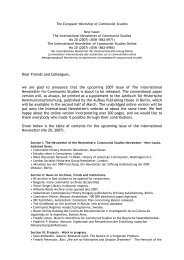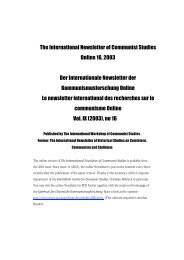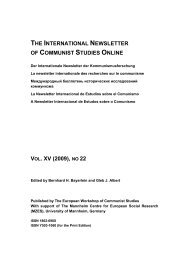Vol. XIII (2007), no 20 - The International Newsletter of Communist ...
Vol. XIII (2007), no 20 - The International Newsletter of Communist ...
Vol. XIII (2007), no 20 - The International Newsletter of Communist ...
Erfolgreiche ePaper selbst erstellen
Machen Sie aus Ihren PDF Publikationen ein blätterbares Flipbook mit unserer einzigartigen Google optimierten e-Paper Software.
<strong>The</strong> <strong>International</strong> Newletter <strong>of</strong> <strong>Communist</strong> Studies Online <strong>XIII</strong> (<strong><strong>20</strong>07</strong>), <strong>no</strong> <strong>20</strong> 135<br />
were accepted. <strong>The</strong> final shutdown followed in early 1938 when the Comintern workers<br />
including the Finnish ILS teachers were severely hit by Stalinist terror. <strong>The</strong> last Finnish<br />
students had to witness the disappearance <strong>of</strong> their leaders in Moscow. After a curious<br />
additional year, the majority <strong>of</strong> the graduates was sent back to Finland in the autumn <strong>of</strong><br />
1938. <strong>The</strong> former ILS students that had remained in the USSR and assimilated into Soviet<br />
society were at the greatest risk <strong>of</strong> becoming terror casualties.<br />
<strong>The</strong> ILS was saturated with ideology and propaganda. <strong>The</strong> study analyzes especially the use<br />
<strong>of</strong> history as a vehicle <strong>of</strong> ideological standardisation and as instrument <strong>of</strong> power. Special<br />
attention is paid to the effects <strong>of</strong> Stalin’s intervention at the ILS and inside the CPF.<br />
<strong>The</strong> book describes the life <strong>of</strong> Finns at the ILS and outside the school. <strong>The</strong> fate <strong>of</strong> the ILS<br />
Finns after their studying or teaching period in Moscow are described in detail. <strong>The</strong> ILS Finns<br />
have been compared to students and teachers from the other ILS sectors, especially the<br />
British and the Irishmen, the Austrians and the Scandinavians that were <strong>of</strong>ten taught by the<br />
Swedish speaking Finns. <strong>The</strong> protagonist among the teachers is Yrjö Sirola, who was called<br />
“father <strong>of</strong> the CPF cadres”.<br />
Soviet education was <strong>of</strong> great importance in Finland in the post WW2 period. Three former<br />
students became ministers <strong>of</strong> the Finnish governments (1945–1948), and 12 <strong>of</strong> them were<br />
elected to parliament. <strong>The</strong> training at the ILS, however, did <strong>no</strong>t contribute to revolution in<br />
Finland. Instead, the ILS-educated cadres took the power inside the CPF. <strong>The</strong> Stalinist<br />
methods <strong>of</strong> cadre policy, organisation and discipline were applied to the party’s own ranks.<br />
<strong>The</strong> CPF’s inner circle kept the power for a relatively long period, until the mid-1960s.<br />
<strong>The</strong> archival materials are collected from the RGASPI (Moscow), the National Archives and<br />
the People’s Archives (both in Helsinki). In the study, the most <strong>of</strong>ten theorist referred to is<br />
Erving G<strong>of</strong>fman with his concept <strong>of</strong> total institutions.<br />
<strong>The</strong> main heading <strong>of</strong> the study, “A Short Course <strong>of</strong> Stalinism”, crystallises the interpretation<br />
<strong>of</strong> the ILS as a school for the ideological coherence <strong>of</strong> Stalinism. On the other hand, the title<br />
includes a statement about the deficiency <strong>of</strong> the Stalinist education, with the schooling at the<br />
ILS being restricted to one year only.<br />
Saarela, Tau<strong>no</strong>: Kansan Tahto. Pohjolan työtätekevien lehti, Jyväskylä,<br />
Gummerus Oy, <strong>20</strong>06. 448 p.<br />
Newspapers have been important for the Finnish labour movement. <strong>The</strong> first labour<br />
newspaper was founded in Helsinki in 1886 and by the end <strong>of</strong> the century there were three<br />
papers in the country. An actual wave <strong>of</strong> foundation took place in 1905-06 when labour<br />
associations in various towns started their own newspapers. That coincided with the dramatic<br />
membership increase <strong>of</strong> the labour movement as the ban on the creation <strong>of</strong> new organisations<br />
issued in 1899 by the Russian authorities, had been lifted after the general strike in November<br />
1905. <strong>The</strong> general strike also made the tsar to give a promise to establish a new unicameral<br />
parliament based on universal suffrage in Finland.<br />
Many <strong>of</strong> those newspapers born after the general strike have disappeared but Kansan Tahto<br />
(Will <strong>of</strong> the People), which started in Oulu in the beginning <strong>of</strong> February 1906, is still alive.














